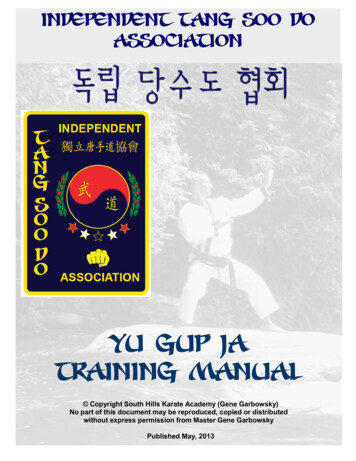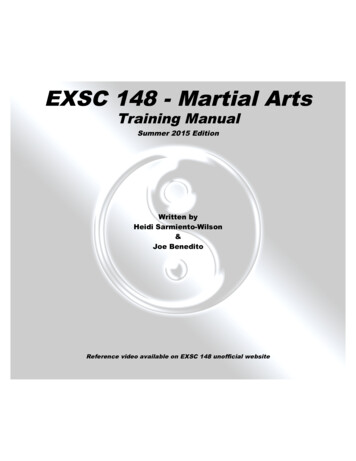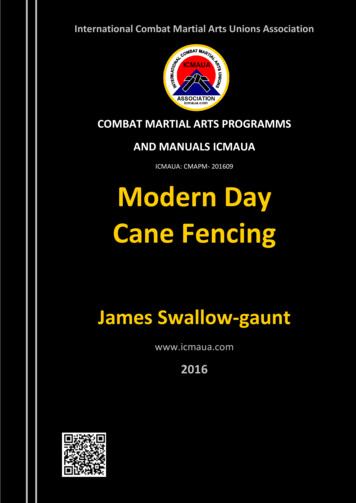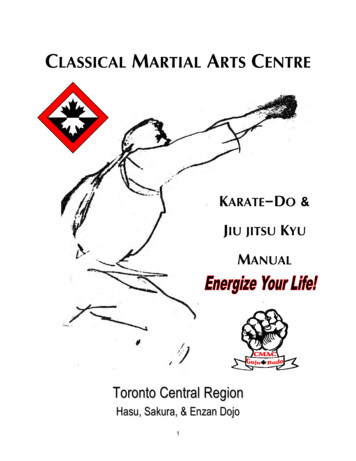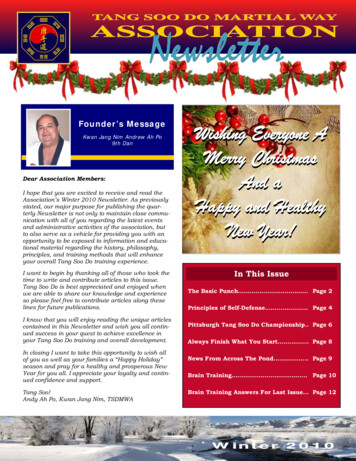
Transcription
TANG SOO DO MARTIAL WAYASSOCIATIONNewsletterFounder’s MessageKwan Jang Nim Andrew Ah Po9th DanDear Association Members:I hope that you are excited to receive and read theAssociation’s Winter 2010 Newsletter. As previouslystated, our major purpose for publishing the quarterly Newsletter is not only to maintain close communication with all of you regarding the latest eventsand administrative activities of the association, butto also serve as a vehicle for providing you with anopportunity to be exposed to information and educational material regarding the history, philosophy,principles, and training methods that will enhanceyour overall Tang Soo Do training experience.I want to begin by thanking all of those who took thetime to write and contribute articles to this issue.Tang Soo Do is best appreciated and enjoyed whenwe are able to share our knowledge and experienceso please feel free to contribute articles along theselines for future publications.I know that you will enjoy reading the unique articlescontained in this Newsletter and wish you all continued success in your quest to achieve excellence inyour Tang Soo Do training and overall development.In closing I want to take this opportunity to wish allof you as well as your families a “Happy Holiday”season and pray for a healthy and prosperous NewYear for you all. I appreciate your loyalty and continued confidence and support.Tang Soo!Andy Ah Po, Kwan Jang Nim, TSDMWAWishing Everyone AMerry ChristmasAnd aHappy and HealthyNew Year!In This IssueThe Basic Punch . Page 2Principles of Self-Defense. . Page 4Pittsburgh Tang Soo Do Championship. Page 6Always Finish What You Start . Page 8News From Across The Pond . Page 9Brain Training Page 10Brain Training Answers For Last Issue Page 12Winter 2010
“The Basic Punch”(Choong Dan Kong Kyuck)Master Kevin WatsonMyrtle Beach, South CarolinaDuring the annual clinics and training held at Garbowsky, Sa Bom Nim’s Dojang last year in Pittsburgh, Kwan Jang Nim posed a question to those inattendance. He asked: “What technique do we practice more than any other but use the least?” After abrief pause, he gave the answer: “Choong Dan KongKyuck” or, literally translated in English: “LungePunch”.As explained by Kwan Jang Nim (and shown in ourown training ), we repeat this technique more thanany other in our basics, Hyung, and partner training such as Il Soo Sik/Sam Soo Sik Deh Ryun. Yet,again, how often do you see this technique used byyourself, or others, in practice?Well, of course, this gave me a lot of inspiration topractice, research, and look deeper into what KwanJang Nim told us that day (which is always the caseafter getting the opportunity to train with him)! Inthe process, I have found a few interesting bits ofinformation In the Japanese Budo, the term “Oi Zuki” is used tomean: “lunge punch”, or what we refer to in TangSoo Do as “Kong Kyuck”, regardless of where thepunch is thrown ( Choong Dan, Sang Dan, etc.).However, a brief look at the deeper meaning behindthese words could help us in our approach andtraining with this technique.“Zuki”, or more correctly, “Tsuki” in Japanese, is literally translated to “Spear” in English. Sometimes,it is also translated as “thrust”, as in the type of motion one would make with a spear. This is important when one looks at the history of Japanese Karate-Do, which is actually a fairly recent development in Martial Arts as compared to the other, olderarts such as Iai-Do or Ken-Do/Ken-Jitsu (swordarts). When the Japanese on the main islands ofJapan (above Okinawa) absorbed the Karate of Okinawa into their Budo, one of the things they did wasto change a great deal of the approach and trainingmethods. This extended to the language they usedto describe basic techniques, and that is why theterm “tsuki” or “spear” was used to describe an unarmed punch. The reason is all too simple--prior toJapan accepting Karate from Okinawa, the majorityPage 2of martial arts practice in Japan was weaponsbased. Very few people practiced unarmed martialarts. Therefore, it was natural for them to use language which would help them to convey what it wasthey were trying to teach. The term “tsuki” seemedto work to describe the punch. A type of thrustingor stabbing motion similar to what someone woulddo with a sword, for example. Still, though, howdoes this help us today?By looking at the history of not just the Japanesearts but of all martial arts of Asia, we can see asimilar concept concerning an “attack”. In theJapanese arts, the saying “Ikken Hitatsu” is used.This saying literally means, “one strike, one kill”. IfI am not mistaken, I believe the term in Korean issomething like: “Il Kyok Pil Sung” ( one strike, certain victory ).It is important to remember, though, that theseterms came from a time when the majority of martial arts practiced involved weapons, particularlyswords, that could indeed kill with one strike. Problems have arisen ever since with well-meaning martial artists believing (literally) that the physical goalbehind these words is to stop (or kill/maim/etc.) anattacker with just one punch.Although of course it is possible to end a fight oreven seriously injure someone with just one attack,perhaps it would be better for us as martial artiststo look at the spirit of what is being conveyed bythese terms--a sense of urgency.Gichin Funakoshi, the founder of Shotokan, wouldconstantly remind his students to “think of yourhands and feet like swords”. Although, again, Funakoshi came from the Feudal Era of Japan whereweapons use was commonplace, this advice stillresonates today.For example, when practicing sparring, try to thinkof the quality of the techniques you use rather thanthe quantity of techniques you “throw” against apartner. Use sparring as a method of preparing foran actual fight by your mental approach. (This subject alone can be covered in another article. )Kwan Jang Nim has given us a great deal of information on how to practice the basic punch in our IllSoo Sik and Sam Soo Sik Deh Ryun techniques. Ashe explained, sometimes the concept of sparring isintimidating to beginners and juniors. By practicingsparring techniques in this format, it acts as a“bridge” between basic technique and free-sparring,allowing students to gain better confidence and skillin using these techniques.Of course, part of this practice is using the “lungeTang Soo Do Martial Way Association - Winter 2010
punch”--over and over again--as both partnerstrain. But again, how can we use the punch inactual sparring?During the clinics and training mentioned earlier,Kwan Jang Nim demonstrated the punch over andover again--both with and without a partner. And,one of the things that I noticed (and will always beworking on) is the timing and footwork of thepunch. I remembered him using the punch as hedemonstrated on me and other members. No onecould really block the punch even though you knewwhat technique was coming! This is of course because Kwan Jang Nim has practiced this techniquefor many years, and used it many times. This reminds me of a statement I heard years ago and tryto apply to punching practice today: “The blademust move before the body”. Although this is astatement used in sword arts such as Kendo or IaiDo, it can be used in empty hand practice as well.Although we are taught as beginners to punch withChoong Dan Kong Kyuck as we step (punching oncompletion of the stepping motion), with furtherpractice we can begin to change the timing of thestep and the punch. I believe that this is what I sawwhen Kwan Jang Nim demonstrated quite convincingly how to deliver the punch - the punch reachedthe target before the step was completed. The“blade” (punch) moved before the body. As a result,the punch becomes almost impossible to stop. Still,the hip is used in the same way as when we firstbegan to learn basics. Only the timing haschanged.In closing, please practice the basic “lunge punch”.Practice it in sparring, with different opponents andin different ways. I think you will be amazed at howsuccessful you will be! After all, as Kwan Jang Nimreminded us about a year ago “no one hardly practices this technique anymore ”I hope this brief article has given you some food forthought. Merry Christmas and Happy New Year toall!!!Tang Soo!!!Other NewsUpcoming Events2011Aug11 - 14Worldwide Tang Soo Do Family2nd Biennial All Tang Soo DoInternational FestivalLake Buena Vista, FloridaPittsburgh, PennsylvaniaMaster Gene Garbowsky of South Hills KarateAcademy is currently hard at work renovatingspace that will house his second Do Jang in thenearby town of Pleasant Hills.With a total of 4,800 s.f. of space, nearly 2,100 s.f.will be devoted to Tang Soo Do training. The balance will include a state-of-the art fitness facilitywith an internet café / juice bar and other services.Sanford, Florida“Family”After 4 1/2 years of sharing space at both a fitness center and the local parks & recreation facility, Master Tino Terrigno decided it was time forTwo Dragons Tang Soo Do to have its own newhome and is also in the process of making renovations.Located in the quaint downtown historic district ofSanford, the space is 1,800 s.f. overall with anopen training area of nearly 1,200 s.f.A family is a place where mindscome in contact with one another. BuddhaTang Soo Do Martial Way Association - Winter 2010Like Master Garbowsky, Master Terrigno is dealing with all the challenging hurdles associatedwith extensive tear-outs and rebuilding. Updateson both these Do Jangs will appear in our nextissue.Page 3
Awareness“Principles ofSelf-Defense”Master Constantino TerrignoSanford, FloridaAsk most people what self-defense means and theanswer almost always is “defending myself from anattack”. For many who have been training for awhile it is soon associated with Ho Sin Sul, or thehand-to-hand techniques they’ve come to learn. Inreality, it is much more than either of those. It is thepractice of any and all concepts and approachesthat “keep us safe”, and therefore includes how we“think” about self-defense.As I tell my students, “on an unconscious level,we unknowingly participate in our own victimization.”Does that mean that being attacked is our fault?Not at all. It simply means that lack of awareness both self-awareness and awareness of our surroundings, can help to create the conditions thatmake it easier for us to become victims.Self-awareness - how we view ourselves is conveyedto those around us through our body language (howwe carry ourselves), and through our voice. So it isimportant to determine whether we project characteristics that set us up as “easy targets” and eliminate them. For instance: Timid, shy, self-conscious, fearful - lack of eyecontact, looking down while walking, poor posture, hands in pockets, low voice.Confident, assertive, in control - makes eyecontact when speaking, back straight, handsswinging at side while walking, louder, more assertive voice.Safety is about risk, and as we all know, there arerisks everywhere. There are financial risks, health risks and the dangers and risks associated withcrime. Even the simple act of stepping outside on asnowy day brings the risk of slipping and falling. Iffor example, we gave nothought to the possible icyAwareness of our surround“On an unconscious level, weconditions outside and wentings - pre-occupation is theout with normal street shoes,unknowingly participate inleading cause of “tunnel viwe magnify the risk. But putsion” where all external, surour own victimization.”on some boots with treads onrounding stimuli are blockedthe bottom and the risk isout. This is a problem (safetygreatly reduced, and the only thing that was rerisk) in anything we do in our day to day affairs, esquired on our part was forethought - being aware ofpecially driving. Our attention should always be tothe risk and taking action to avoid or reduce it. If wewhat and who is around us.should happen to fall even after having taken theproper precautions, then our only alternative is toAwareness also means understanding your environrely on that cool break-falling technique we learnedment and sometimes, the psychology of conflict andin class.crime. It is sometimes helpful to think of criminalsor troublemakers as animals in the wild. Like aniThe point is, whether a threat is from our naturalmals, they are adept at sizing up and stalking theirenvironment or someone who means to do us harm,targets who are generally the aged, the weak (or inthe principles that keep us safe are the same andjured), the fearful, those that are alone, or the uncan be condensed to awareness, avoidance andaware (pre-occupied).reaction. The first two are proactive and the last,reactive, and as we all know from our Tang Soo DoPredators want easy targets and more often thantraining, fighting is the last option after all othersnot, carry out their attacks quickly, taking you byhave been exhausted. Self-defense begins in thesurprise. Predators prefer not to waste time withmind.those who “look” like they are prepared, who will assert themselves or fight back. The prepared orWhat follows is some of the information containedaware individual is trouble that will slow them downin a manual I created for my Women’s Self-Defenseand increase the risk of their getting caught or posseminars which, although written primarily as asibly injured themselves. Unless they are desperatepractical guide for non-martial artists, helps illusor operate in a group, they will move on to an easiertrate how these three areas play a major role invictim. So:helping us to stay safe. It is by no means a completecoverage of this topic. That would easily require an Always scan your surroundings. Look alert.entire book. Focus on nothing but take in everything.Page 4Tang Soo Do Martial Way Association - Winter 2010
Pay attention to those around you who seem outof place or everywhere you are.Don’t let anyone enter your personal safety zonewhich is at minimum an arm’s length.Remember that someone innocently asking for thetime can be setting you up. Don’t drop your guard.Avoidance (Planning)As you know, Tang Soo Do is a defensive martial artwhere we seek “not to fight” or to avoid or preventan encounter. The word avoid in this context doesnot mean walking away (reactive) but rather, notputting ourselves at risk in the first place(proactive). To be really prepared, good self-defenserequires retraining of the mind to create a defensive“mindset”. Practicing defensive thinking should notbe viewed as paranoia but instead, as a positivedaily habit.For instance: Will it be after dark when you leave the storeand if so, where will you park?Will you pull your car straight into the space orback it in? (it’s easier to drive right out in anemergency than to back out first).If you’re going to be late or away, does anyoneknow where you are and when you’re expectedback?Always leave yourself an escape route. Neverallow yourself to be cornered.Even with this abbreviated list you can see thatpracticing good mental self-defense is a multifaceted process that should, for the most part, helpsignificantly increase your level of safety.As a side note, I worked in New York City for over13 years and frequently used all modes of transportation such as subways, buses, cabs and walking,very often through areas considered unsafe. Anexercise I used extensively was running through“what if” scenarios where I would create an encounter situation using the actual conditions I was in(say, on a crowded train) and assess whether I wasin a good or poor position to react to a possiblethreat from any number of sources. The possibilitieswere endless and educational for, over time, I foundmyself doing things differently, always positioningmyself beforehand so as to optimize my chances ofa successful outcome. This is a valuable (and fun)exercise you can do anywhere. Try it the next timeyou’re driving and see a new level of alertness.Reaction (Physical Defense)Well, you did all you could to be aware and avoidTang Soo Do Martial Way Association - Winter 2010but now the threat is inevitable. What do you do?In nature, when animals are threatened by one ormore predators that are more powerful, their firstinstinct is to run. If escape is not possible they willfight back. This is called the “fight-or-flight” response and it occurs in people as well.Unfortunately, there is also the what is called the“freeze” response, where the victim is totally incapacitated physically and neither runs nor offers anyresistance. It is brought on by an overwhelming fearof the situation whether the threat is real or imagined.Should an encounter escalate into a physical confrontation keep these points in mind: Breathe to remain calm.Never put yourself or loved ones in harm’s wayfor the sake of personal possessions.When defending your space, never standsquared to or fully facing your opponent. Alwaysangle the body slightly to avoid being pushed orpulled off balance. It also presents a smaller target and provides a better position from which tolaunch your own attack.Do the unexpected.Use your hips when striking to extend reach andincrease power.Deliver strikes to soft, vulnerable areas.Make small circles if twisting to create moretorque.Use your whole body against the opponent’sweakest point.Yell (Ki Hap) to release energy and startle youropponent.When you commit to do battle, be as fierce orfiercer than your opponent. Find the animal inYOU.The real enemy is your mind. You must first defeatyour own mind and your notions of what you canand can’t do in order to survive.And finally,“If you don’t understand yourself, youwill lose one hundred percent of the time.If you understand yourself,you will win fifty percent of the time.If you understand yourself and youropponent, you will win one hundredpercent of the time.”-Tsutomu OshimaPage 5
Page 6Tang Soo Do Martial Way Association - Winter 2010
Tang Soo Do Martial Way Association - Winter 2010Page 7
“Always Finish What You Start”Sónia C. C. Lopes - 6th GupSouth Hills Karate Academy, Pittsburgh, PA“Always Finish What You Start,” Tang Soo Do’stenth Article of Faith is not always easy to follow;particularly, when interrupting a life of martial artswas never the end goal of joining in the first place Back in September of 2009, I received a phone callfrom Children’s Hospital. My two year old son,Santiago, needed to have his blood work repeatedprior to having a tonsillectomy and adenoidectomy.So, we went over to Jefferson Hospital and filled upanother six or seven tubes of blood. Another phonecall came: his blood was not coagulating quicklyenough. This meant several more trips to Children’sHospital to figure out what was happening. It wasquite frightening to hear, “You need to go to Hematology, which is in the same section as Oncology.”The nurse quickly added that there was no reasonto panic about such coincidence, which, of course,made me panic. I was very anxious, nervous, simplyterrified. Several days later, another call camethrough. Santiago’s diagnosis: hemophilia. My first,second, and third sighs were of relief, “Thank God itis not cancer!”I was asked to take my other two boys for someblood work as well and, as it turns out, they alsohave this bleeding disorder. It is a condition wherethe affected individual’s blood takes longer to coagulate than usual. There are three different levels:severe, moderate, and mild. Luckily, my boys havethe mild hemophilia, which is of utmost concernonly in case of a serious injury (e.g., a car accident)or during surgery. I was given lots of literature onunderstanding the disorder, recommended activities, and the level of danger of a wide gamut ofsports. Although these guides are wonderful interms of providing knowledge, they also make someone like me (who tends to be quite drastic and overprotective) even more anxious about everything inwhich my children are involved.And this brings me to Tang Soo Do. With all theblood tests, uncertainty, and concerns, we began tonot attend class. “I’m too tired!” “We don’t feel likeit!” “We have another doctor’s appointment this afternoon!” “Dad wants to go out to dinner!” “Oops! Iforgot and now it’s too late!” These and others allbecame acceptable and expected excuses. Santiago’s surgery was on December 17th and everythingturned out well. But, now there were the healingweeks, Christmas, New Year and the awful winterweather. Some valid, but most not so valid excusesto make it to March without Tang Soo Do.After quite a few months, I am now calmer aboutthe whole hemophilia deal. I want my boys, mydaughter, and me back in Tang Soo Do. I want uskicking, sparring, and breaking boards (after all,this is what my five year-old, Ari, lives for). Besides,if the boys ever get into trouble somewhere, I highlydoubt someone will stop and ask, “Do you guyshave a bleeding disorder?” And, above and beyond,we all enjoy Tang Soo Do. It is re-energizing, positive, mindful, and a great stress reliever. It is onething that I do not want to cut short and that I donot want my kids to lose.Some may think I am being careless with my children; however, I believe otherwise. João, my eightyear old, and Ari know about their condition andthey already have to deal with sitting and watchingduring physical education classes while their classmates have a wonderful time playing basketball andtag-football, among other sports. They do not needone more reason, besides having an overprotectivemother, to hold them back. I think I am being conscientious and real. I think I am trying to let themfinish what we have started: a life with Tang Soo Do.It has now been several months since I was informed of my boys’ disorder. In July, we learnedabout the first karate tournament sponsored by ourinstructor Master Gene Garbowsky, head instructorat South Hills Karate Academy in Pittsburgh, PA.Ari, João, and my daughter Xochitl immediately requested to participate, and I could not say no. Theychose to compete in forms, breaking, and sparring.I have to admit that I was quite stressed about thepossibility of an injury, particularly, during breaking. Master Garbowsky, however, continued to pushthem to practice more and more, and helped meconvey to my children that the most important partwas to actually participate, regardless of the results.This would be a learning experience and a confidence builder.Ari placed first in breaking, second in forms, andthird in sparring. João placed second in breakingand third in forms and sparring. Xochitl placed firstin sparring, second in forms, and third in breaking.They all enjoyed the competitive environment andcame out with new goals in mind: to do better forthe next tournament through practice, practice,practice.Throughout our everyday life, we are faced withContinued on page 11Page 8Tang Soo Do Martial Way Association - Winter 2010
News From Across The PondLarge swathes of the UK were snow boundon Saturday the 11th of December 2010.Fortunately for the British Tang Soo DoFederation (BTSDF), the Midlands had allbut immerged from its frozen white blanket. Neither the weather nor the recentprevalent cold and flu bouts managed todampen the enthusiasm of the participants at the last Gup Graduation for the2010 BTSDF calendar.The assessment was held at the RugbySchool Sports Centre, the recent venue for the 3rd BTSDF Annual Expo. Over one hundred Membersassessed on the day with an additional thirty 'Tigers' age group Members attending the West Midlands'mop-up' grading on the Sunday morning.The quarterly BTSDF 'Top-Tiger Award' was given to Tom Cornall, a who attends the Warwick class. Tomhad trained for six months to prepare for his first assessment and was deemed to have made outstandingpersonal progress.During the past four years the BTSDF has augmented its curriculum to come in line with practices of theGrandMaster Ah Po's Tang Soo Do Martial Way Association and hence move closer to the latter practices ofthe art's Founder, Great-GrandMaster Hwang Kee.The effects of this ongoing augmentation could be witnessed in the smoothrunning of the Gup assessment. Light but energetic 'Choon be won duong’ (readying exercises) were followed by demonstrations of the student's formrequirement before moving on to one-step sparring combinations where-inMembers displayed their 'intent regard' 'technical knowledge' and 'personalprogress'. The one-step sparring combinations continued into the partner workportion of the assessment, then progressed on to free sparring. Participantsthen lined in rank order for the breaking ceremony in front of the Masters'John Dove and Simon Preston before approaching Master Adam Preston inreadiness for their general knowledge questions.All things being considered, Saturday the 11th of December was a successfuland enjoyable day. A day that allowed the BTSDF to demonstrate the progressthat the previous four years’ association with the Tang Soo Do Martial WayAssociation has facilitated. What's next for the BTSDF? Well, we can guaranteemore well aimed augmentation for 2011, BUT until then, lets hope that theweather that the rest of the country has endured will allow us to experience a white Christmas ?On behalf of the Members of the British Tang Soo Do Federation, we wish you and your loved ones thewarmest of seasons greetings and all that you would wish for yourselves in 2011.Tang Soo Do Martial Way Association - Winter 2010Page 9
Brain TrainingHow many animals can you find in the picture below?Page 10Tang Soo Do Martial Way Association - Winter 2010
Continued from page 8challenges or “tournaments.” Tang Soo Do preparesus to become more aware of our surroundings andof other individuals’ actions and reactions. Itteaches us how to better react, adapt, learn, andgrow from both the positive and the negative aspects of any situation. One of my boys’ lifelong challenges is hemophilia. Others, hopefully not as serious, arise on a daily basis, and the goal, throughTang Soo Do, is to be better able to work throughthem. While perfecting techniques through continuous practice, my children are learning how to attackand how to defend, when to step back and watch,and when to step forward and act. They are growingstronger physically and emotionally and I withthem.Although I still worry, particularly when I see orhear about some of the injuries, I am glad my children are a part of the Tang Soo Do world. They areexercising on a regular basis, they are becomingmore disciplined and more confident and, they areeven more respectful. Santiago, now three, has already begun taking classes and, soon enough, hewill also be competing.As a mother and as a student, I will continue toremind my children to “Always Finish What YouStart.”TSDMWA Training VideosGrandmaster Ah Po’sThe Seven TrainingPrinciples of theHighly EffectiveMartial ArtistVHS 49.95Add 5.00 S & HGrandmaster Ah Po’sTang Soo Do Training Combinations3 DVD Set 79.95Add 5.00 S & HTang Soo DoMartial Way Association, Inc.Founder and PublisherAndrew Ah Po - Kwan Jang Nim5504 Oak River CourtCarmichael, CA 95608, USA916-487-0544ahpotangsoodo@yahoo.comMember Technical Advisory CommitteeMaster Stephen PropstEditorMaster Constantino TerrignoSend information, articles, photos to:Constantino Terrigno atsabomnimct@bellsouth.netSubmission deadline for all issuesBack: Master Gene Garbowsky, Sónia LopesMiddle: Ari Lopes, Jao Lopes, Xochitl Lopes andFront: Santigo LopesTang Soo Do Martial Way Association - Winter 2010Spring - March 1stSummer - June 1stFall - September 1stWinter - December 1stPage 11
Brain Training Answers for Fall 2010What’s Missing?Compare the photo A and B below and find the 5 things missing in B.Master McCoy’s Research ChallengeIn the last issue, I posed thequestion “What does the sign(at right) outside a martial artstraining hall mean?The answer, depending on thesource, varies a little. But thegeneral meaning, when thewords kama and wan are puttogether, is “we don’t care if youcome in or not”, or “We don’t care if you challengeus”.I read this for the first time in the mid 1990’s in abook called “KODO, Ancient Ways” by Kensho Furuya, who, among other things, is an Aikido teacherand Iaido teacher. I would recommend checkingthis book out no matter what system you study.The confidence in your system to have that mindsetcan be interpreted to also mean, in a more modernway of thinking, that “We don’t mind if you ask usPage 12questions”. If you putyourself out there as apractitioner or teacherof anything, you shouldprobably know whatyou’re talking about, orat least how to find theanswers. It seems toalways come back to Ahpoisms ”Don’t try to beon the outside what you are not on the inside”!My thanks to Sa Bom Nim Kevin Watson, who knewthe correct meaning, and to Mr. Joe Avalos, ofSanta Maria, California, who also sent the correctanswer. And thank you to Sonia Lopes, 6th Gupfrom South Hills Karate Academy in Pittsburgh, PA,who sent an answer. And although it wasn’t theanswer I was looking for, Sonia had the Yong Gi totry, and that’s what it takes to succeed at anything.Her answer for a sickle and a rice bowl was “youreap what you sow in your training”. How couldthat answer be wrong?Tang Soo!!Tang Soo Do Martial Way Association - Winter 2010
Page 2 Tang Soo Do Martial Way Association - Winter 2010 of martial arts practice in Japan was weapons-based. Very few people practiced unarmed martial arts. Therefore, it was natural for them to use lan-guage which would help them to convey what it was they were trying to teach. The term "tsuki" seemed to work to describe the punch.
